Inflammatory microRNA-194 and -515 attenuate the biosynthesis of chondroitin sulfate during human intervertebral disc degeneration
- PMID: 28514734
- PMCID: PMC5564769
- DOI: 10.18632/oncotarget.17571
Inflammatory microRNA-194 and -515 attenuate the biosynthesis of chondroitin sulfate during human intervertebral disc degeneration
Abstract
Intervertebral disc degeneration (IDD) is characterized by dehydration and loss of extracellular matrixes in the nucleus pulposus region. Chondroitin sulfate has been found to be the water-binding molecule that played a key role in IDD. Although investigators have reported that inflammatory cytokines are involved in the reduction of chondroitin sulfate in IDD, but the underlying mechanism is unrevealed. Since chondroitin sulfate synthesis is controlled by chondroitin sulfate glycosyltransferases CHSY-1/2/3 and CSGALNACT-1/2, their functional role and regulatory mechanism in IDD is not fully studied. Here, we set out to investigate the function and regulatory roles of these factors during IDD development. We found that among these chondroitin sulfate glycosyltransferases, CHSY-1/2/3 are significantly down-regulated in severe IDD samples than mild IDD samples. In vitro experiments revealed that Interleukin-1β and Tumor Necrosis Factor-α stimulation led to significant reduction of CHSY-1/2/3 at protein level than mRNA level in NP cells, indicating a post-transcriptional regulatory mechanisms are involved. By computational prediction and analysis, we found that inflammatory cytokines stimulated microRNA-194 and -515 target CHSY-1/2/3 mRNA and significantly interrupt their translation and downstream chondroitin sulfate deposition. Inhibition of microRNA-194 and -515 however, significantly rescued CHSY-1/2/3 expressions and chondroitin sulfate deposition. These findings together demonstrated a vital role of inflammatory stimulated microRNAs in promoting intervertebral disc degeneration by interrupt chondroitin sulfate synthesis, which may provide new insights into the mechanism and therapeutic approaches in IDD.
Keywords: biosynthesis; chondroitin sulfate; glycosyltransferases; intervertebral disc degeneration; nucleus pulposus.
Conflict of interest statement
The authors disclose no potential conflicts of interest.
Figures

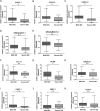
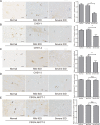

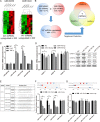
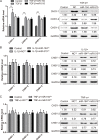
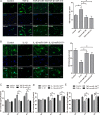
Similar articles
-
Chondroitin synthase-3 regulates nucleus pulposus degeneration through actin-induced YAP signaling.FASEB J. 2020 Dec;34(12):16581-16600. doi: 10.1096/fj.202001021R. Epub 2020 Oct 22. FASEB J. 2020. PMID: 33089528
-
Profiling and bioinformatics analysis of differentially expressed circular RNAs in human intervertebral disc degeneration.Acta Biochim Biophys Sin (Shanghai). 2019 Jun 20;51(6):571-579. doi: 10.1093/abbs/gmz036. Acta Biochim Biophys Sin (Shanghai). 2019. PMID: 31056633
-
MicroRNA-7 regulates IL-1β-induced extracellular matrix degeneration by targeting GDF5 in human nucleus pulposus cells.Biomed Pharmacother. 2016 Oct;83:1414-1421. doi: 10.1016/j.biopha.2016.08.062. Epub 2016 Aug 30. Biomed Pharmacother. 2016. PMID: 27583982
-
MicroRNA in intervertebral disc degeneration.Cell Prolif. 2015 Jun;48(3):278-83. doi: 10.1111/cpr.12180. Epub 2015 Mar 4. Cell Prolif. 2015. PMID: 25736871 Free PMC article. Review.
-
Regulatory Effect of Inflammatory Mediators in Intervertebral Disc Degeneration.Mediators Inflamm. 2023 Apr 17;2023:6210885. doi: 10.1155/2023/6210885. eCollection 2023. Mediators Inflamm. 2023. PMID: 37101594 Free PMC article. Review.
Cited by
-
miR-194 suppresses epithelial-mesenchymal transition of retinal pigment epithelial cells by directly targeting ZEB1.Ann Transl Med. 2019 Dec;7(23):751. doi: 10.21037/atm.2019.11.90. Ann Transl Med. 2019. PMID: 32042767 Free PMC article.
-
Sweet Control: MicroRNA Regulation of the Glycome.Biochemistry. 2020 Sep 1;59(34):3098-3110. doi: 10.1021/acs.biochem.9b00784. Epub 2019 Oct 21. Biochemistry. 2020. PMID: 31585501 Free PMC article. Review.
-
The potential role and trend of HIF‑1α in intervertebral disc degeneration: Friend or foe? (Review).Mol Med Rep. 2021 Apr;23(4):239. doi: 10.3892/mmr.2021.11878. Epub 2021 Feb 4. Mol Med Rep. 2021. PMID: 33537810 Free PMC article. Review.
-
Investigation of the effect of dipyrone on cells isolated from intervertebral disc tissue.Exp Ther Med. 2019 Jul;18(1):216-224. doi: 10.3892/etm.2019.7576. Epub 2019 May 13. Exp Ther Med. 2019. PMID: 31258656 Free PMC article.
-
Detection of miR‑29a in plasma of patients with lumbar spinal stenosis and the clinical significance.Mol Med Rep. 2018 Jul;18(1):223-229. doi: 10.3892/mmr.2018.8956. Epub 2018 May 3. Mol Med Rep. 2018. PMID: 29749498 Free PMC article. Clinical Trial.
References
-
- Luoma K, Riihimaki H, Luukkonen R, Raininko R, Viikari-Juntura E, Lamminen A. Low back pain in relation to lumbar disc degeneration. Spine. 2000;25:487–92. - PubMed
-
- Deyo RA, Weinstein JN. Low back pain. N Engl J Med. 2001;344:363–70. - PubMed
-
- Kepler CK, Ponnappan RK, Tannoury CA, Risbud MV, Anderson DG. The molecular basis of intervertebral disc degeneration. Spine J. 2013;13:318–30. - PubMed
-
- Vergroesen PP, Kingma I, Emanuel KS, Hoogendoorn RJ, Welting TJ, van Royen BJ, van Dieën JH, Smit TH. Mechanics and biology in intervertebral disc degeneration: a vicious circle. Osteoarthritis Cartilage. 2015;23:1057–70. - PubMed
-
- Sivan SS, Hayes AJ, Wachtel E, Caterson B, Merkher Y, Maroudas A, Brown S, Roberts S. Biochemical composition and turnover of the extracellular matrix of the normal and degenerate intervertebral disc. Eur Spine J. 2014;23:S344–53. - PubMed
MeSH terms
Substances
LinkOut - more resources
Full Text Sources
Other Literature Sources
Research Materials
Miscellaneous

